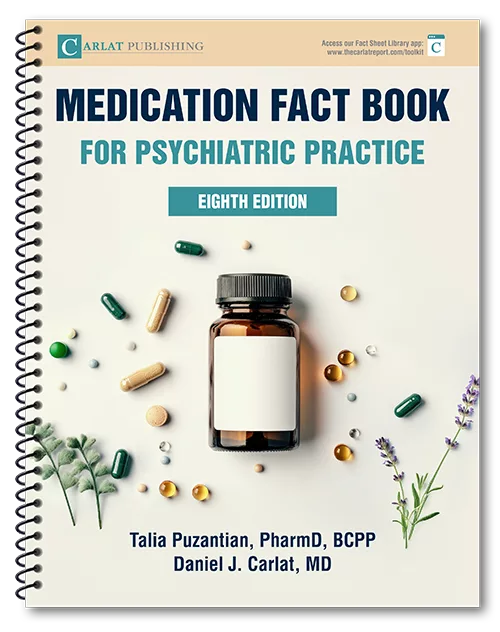Home » A Basic Course in Drug Metabolism
A Basic Course in Drug Metabolism
July 1, 2003
From The Carlat Psychiatry Report
Daniel Carlat, MD
Dr. Carlat has disclosed that he has no significant relationships with or financial interests in any commercial companies pertaining to this educational activity.
We apologize in advance. But it was inevitable that TCR would eventually have to tackle what may be the most boring topic in all of psychiatry, if not medicine in general: Drug-drug interactions. Some of you will be delighted. Many will be dismayed, especially those who have never seen a living, breathing patient experience a drug-drug interaction, despite all the ink that has been expended discussing the issue over the past decade. Those of a cynical bent might argue that concerns about P450 interactions were inflated by pharmaceutical firms as a way of creating new marketing niches for their products.
Well, the truth is more complicated than this. Consider the fact that at least four drugs have been pulled from the market since 1997 solely because of the risk of lethal drug-drug interactions (the antihistamines Seldane and Hismanal, the bowel stimulant Propulsid, and the calcium channel blocker mibefradil). Of more relevance to psychiatrists, in 1997 two cardiac deaths were reported in patients taking the combination of the antipsychotic Orap (pimozide) and the antibiotic and 3A4 inhibitor Biaxin (clarithromycin). Drug-drug interactions are real, and potentially deadly, but how common are they, and what do psychiatrists really need to know to avoid them? This issue of TCR will struggle heroically to provide you with all these answers.
First, some drug metabolism basics. Why do we need drug metabolism at all? Were P450 enzymes placed in the human body merely to perplex and annoy psychiatrists? Or did they evolve for even better reasons than that?
The best thinking among pharmacologists (1) is that metabolism started when early plants realized that they could improve their chances of survival by producing toxins and delivering them to potential predators. While poisoning enemies was good fun, a problem arose: how do you avoid poisoning yourself? Metabolic enzyme systems therefore initially evolved in order to get rid of these endogenous toxins, but they turned out to be quite good at neutralizing exogenous toxins, such as food by-products and (fast-forward three billion years) modern pharmaceuticals.
Drugs that enter our systems need to get into cells to work, which means they have to cross fatty cell walls. Most drugs are fat-soluble in order to accomplish this task. But once in the body, how do we get them out? Primarily by transforming them into water-soluble versions of themselves, so that they can be swept away in (watery) urine or stool.
The P450 enzymes specialize in turning lipophilic ("fat-loving") drugs into water soluble compounds, either by adding a polar group, like a hydroxyl group via hydroxylation, or by stealing some atoms away, like an alkyl group in dealkylation. This process is called "Phase I metabolism.” Next, these polar molecules are joined to other molecules to make them really water-soluble (this is called Phase II metabolism, or conjugation, and the most oft-cited example of this is glucuronidation). Finally, these transformed molecules get excreted into our city plumbing.
By the way, the name "Cytochrome P450 enzymes" is a bit of researcher's jargon. In research laboratories, these enzymes are examined in artificially-created microsomal vesicles. When these enzymes are placed in such vesicles, they give off a colored pigment, and absorb light at a wavelength of 450 nm. Thus, "Cyto"=microsomal vesicles; "chrome"=colored; "P"=pigmented; and "450"=450 nm wavelength of light.
Other common terms: Inhibition happens when your new, "inciting" drug binds more tightly to a P450 enzyme than the old drug. The "victim" drug then gets stuck in a game of metabolic musical chairs as it scurries around looking for an enzyme system to break it down. This leads, rather quickly, to higher drug levels than otherwise. Induction happens when the inciting drug stimulates the production of extra enzymes. With more enzymes around, the victim drug is broken down more rapidly, leading to lower levels. But since it takes a while for all this extra enzyme synthesis to occur, induction, unlike inhibition, does not happen immediately, but takes place over a one to three week period.
A substrate is a drug that is metabolized by a particular enzyme. Thus, for example, tricyclics and beta-blockers are both substrates of the 2D6 enzyme system, because they are both metabolized by that system. A slow metabolizer is a person who is genetically deficient in a certain metabolic enzyme, and thus metabolizes given drugs more slowly, leading to higher than expected serum levels. About 10% of people are slow metabolizers at 2D6. An ultra-rapid metabolizer has too many of a given enzyme, and so chews up a drug as fast as it enters the system. There are simple ways of identifying patients who are slow metabolizers, but such tests have not yet entered clinical practice. The benefits of getting this info are deemed too rarely clinically helpful to justify the expense of screening everyone, though this issue is controversial.
Finally, what's the scoop on serumprotein binding? Most drugs latch onto serum proteins to some extent, but many psychiatric drugs are "highly protein- bound," meaning that at least 95% of the total amount is bound. When one highly protein-bound drug gets dumped into the bloodstream with another highly protein-bound drug, a battle for the sites ensues. Depending on which drug is "stronger," one will get kicked off the protein, leading to higher free fractions, and therefore greater than anticipated drug activity.
Your basic course is now complete, and you are allowed to move on to the next article in this month's issue. Be forewarned: there you will encounter yet another drug interactions chart. We just couldn't resist.
TCR VERDICT: Metabolism Matters!
1. Cozza KL, Armstron SC, and Oesterheld JR. Drug Interaction Principles for Medical Practice, 2nd Ed. Washington, DC, 2003.
General PsychiatryWell, the truth is more complicated than this. Consider the fact that at least four drugs have been pulled from the market since 1997 solely because of the risk of lethal drug-drug interactions (the antihistamines Seldane and Hismanal, the bowel stimulant Propulsid, and the calcium channel blocker mibefradil). Of more relevance to psychiatrists, in 1997 two cardiac deaths were reported in patients taking the combination of the antipsychotic Orap (pimozide) and the antibiotic and 3A4 inhibitor Biaxin (clarithromycin). Drug-drug interactions are real, and potentially deadly, but how common are they, and what do psychiatrists really need to know to avoid them? This issue of TCR will struggle heroically to provide you with all these answers.
The P450 enzymes turn lipophilic drugs into water soluble compounds
First, some drug metabolism basics. Why do we need drug metabolism at all? Were P450 enzymes placed in the human body merely to perplex and annoy psychiatrists? Or did they evolve for even better reasons than that?
The best thinking among pharmacologists (1) is that metabolism started when early plants realized that they could improve their chances of survival by producing toxins and delivering them to potential predators. While poisoning enemies was good fun, a problem arose: how do you avoid poisoning yourself? Metabolic enzyme systems therefore initially evolved in order to get rid of these endogenous toxins, but they turned out to be quite good at neutralizing exogenous toxins, such as food by-products and (fast-forward three billion years) modern pharmaceuticals.
Drugs that enter our systems need to get into cells to work, which means they have to cross fatty cell walls. Most drugs are fat-soluble in order to accomplish this task. But once in the body, how do we get them out? Primarily by transforming them into water-soluble versions of themselves, so that they can be swept away in (watery) urine or stool.
The P450 enzymes specialize in turning lipophilic ("fat-loving") drugs into water soluble compounds, either by adding a polar group, like a hydroxyl group via hydroxylation, or by stealing some atoms away, like an alkyl group in dealkylation. This process is called "Phase I metabolism.” Next, these polar molecules are joined to other molecules to make them really water-soluble (this is called Phase II metabolism, or conjugation, and the most oft-cited example of this is glucuronidation). Finally, these transformed molecules get excreted into our city plumbing.
By the way, the name "Cytochrome P450 enzymes" is a bit of researcher's jargon. In research laboratories, these enzymes are examined in artificially-created microsomal vesicles. When these enzymes are placed in such vesicles, they give off a colored pigment, and absorb light at a wavelength of 450 nm. Thus, "Cyto"=microsomal vesicles; "chrome"=colored; "P"=pigmented; and "450"=450 nm wavelength of light.
Other common terms: Inhibition happens when your new, "inciting" drug binds more tightly to a P450 enzyme than the old drug. The "victim" drug then gets stuck in a game of metabolic musical chairs as it scurries around looking for an enzyme system to break it down. This leads, rather quickly, to higher drug levels than otherwise. Induction happens when the inciting drug stimulates the production of extra enzymes. With more enzymes around, the victim drug is broken down more rapidly, leading to lower levels. But since it takes a while for all this extra enzyme synthesis to occur, induction, unlike inhibition, does not happen immediately, but takes place over a one to three week period.
A substrate is a drug that is metabolized by a particular enzyme. Thus, for example, tricyclics and beta-blockers are both substrates of the 2D6 enzyme system, because they are both metabolized by that system. A slow metabolizer is a person who is genetically deficient in a certain metabolic enzyme, and thus metabolizes given drugs more slowly, leading to higher than expected serum levels. About 10% of people are slow metabolizers at 2D6. An ultra-rapid metabolizer has too many of a given enzyme, and so chews up a drug as fast as it enters the system. There are simple ways of identifying patients who are slow metabolizers, but such tests have not yet entered clinical practice. The benefits of getting this info are deemed too rarely clinically helpful to justify the expense of screening everyone, though this issue is controversial.
Finally, what's the scoop on serumprotein binding? Most drugs latch onto serum proteins to some extent, but many psychiatric drugs are "highly protein- bound," meaning that at least 95% of the total amount is bound. When one highly protein-bound drug gets dumped into the bloodstream with another highly protein-bound drug, a battle for the sites ensues. Depending on which drug is "stronger," one will get kicked off the protein, leading to higher free fractions, and therefore greater than anticipated drug activity.
Your basic course is now complete, and you are allowed to move on to the next article in this month's issue. Be forewarned: there you will encounter yet another drug interactions chart. We just couldn't resist.
TCR VERDICT: Metabolism Matters!
1. Cozza KL, Armstron SC, and Oesterheld JR. Drug Interaction Principles for Medical Practice, 2nd Ed. Washington, DC, 2003.

Issue Date: July 1, 2003
Table Of Contents
Recommended
Newsletters
Please see our Terms and Conditions, Privacy Policy, Subscription Agreement, Use of Cookies, and Hardware/Software Requirements to view our website.
© 2025 Carlat Publishing, LLC and Affiliates, All Rights Reserved.


_-The-Breakthrough-Antipsychotic-That-Could-Change-Everything.webp?t=1729528747)



